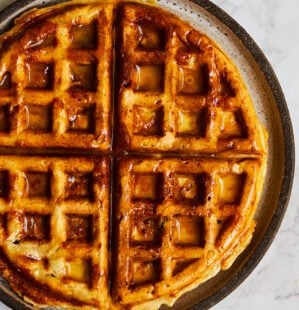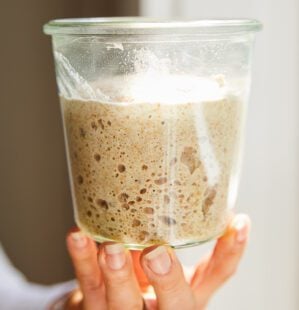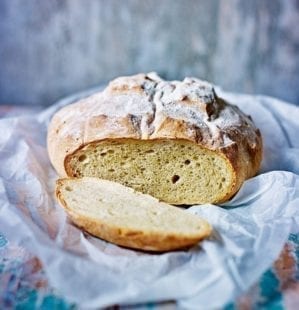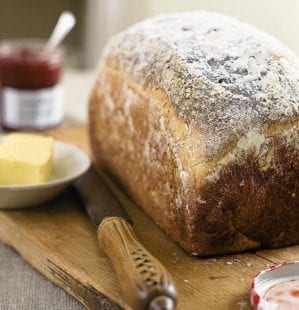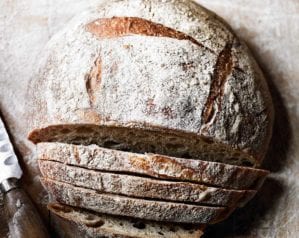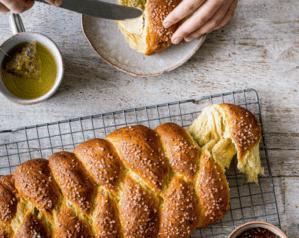
Sourdough loaf
- Published: 5 Sep 23
- Updated: 25 Mar 24
“Welcome to my master recipe. This is the standard recipe that I use every week to make sourdough loaves and rolls for my household. The key to my process is simplicity, and not having to plan your life around the dough, but being able to fit making sourdough into your home and family life,” Elaine Boddy, author of The Sourdough Whisperer.
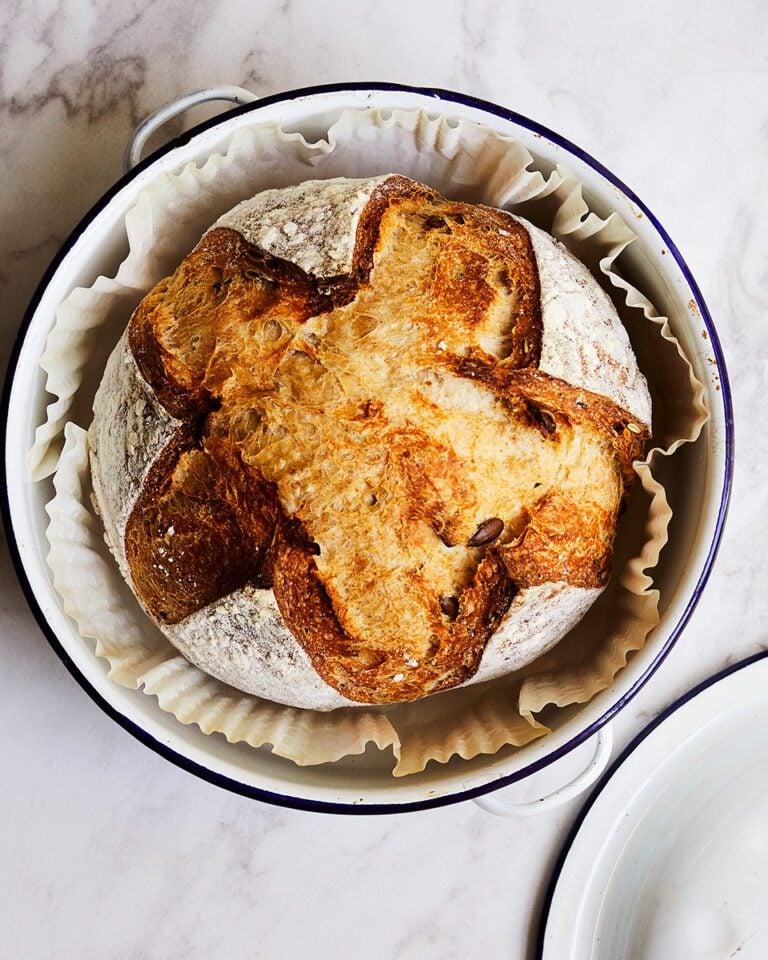
Make this recipe using Elaine’s easy sourdough starter.
-
Makes 1
-
Hands-on time 30 min, over the course of 2 days. Oven time 55 min, plus cooling
Ingredients
- 50g active sourdough starter
- 500g strong white bread flour
- 7g salt
- Rice flour to dust
Specialist kit
- 500-750g banneton
- Lame or razor blade
- Large baking pan with a lid
Method
- I always begin making my dough between 4-5pm. This is my standard timetable, but it can be manipulated for your household. Mix the starter, flour and salt with 350g water in a large bowl until a rough dough forms with no dry flour showing. Cover the bowl with a shower cap or baking paper and leave it for an hour or so on the kitchen counter. Return the rest of your starter to the fridge until you need it again, with the lid firmly fitted.
- Perform the first set of pulls and folds on the dough to build up its structure. To do this, pick up a small handful of dough from one side of the bowl, using your thumb and two forefingers to grab a portion, then lift it, stretch it and fold it over the rest of the dough to the other side of the bowl. Turn the bowl a few degrees and repeat the process: lift and fold, turn the bowl, lift and fold, turn the bowl, and continue until the dough comes together into a smooth(ish) ball. Cover the bowl and leave at room temperature.
- Over the next few hours, at intervals that suit you, perform 3 more sets of the lifting and folding action. Each time, the dough will tell you when it’s time to stop lifting and folding when it comes together into a ball again. Be sure to cover the bowl between each lift and fold. Do a final lift and fold before you go to bed, then leave it (covered) at room temperature overnight to prove. Temperature is important; if the room is 18-20°C, then a prove of 8-10 hours is enough; if it’s colder then it will take longer.
- The next morning, you should have a bowl full of dough that’s doubled in size. Dust your banneton with rice flour, then do another series of lifts and folds to bring the dough into a firm ball. Lift it into the banneton, placing it smooth-side down. Cover and put in the fridge for at least 3 hours (or up to 24 hours).
- When ready to bake, uncover the banneton and put a piece of baking paper on top. Put your baking pan on top upside-down, then in a smooth motion lift the banneton and pan up and over to turn the dough out into the pan. Use a lame or clean razor blade to score the top of the dough, at a depth of 0.5-1cm. Score from the outside into the middle of the dough to create an asterisk which will burst open into a star shape during baking which you can see in my baked loaf.
- Cover the pan with a lid and put in the oven. Turn the temperature to 220°C fan/gas 9 and bake for 55 minutes – don’t open the oven or lid until the time is up. Once the time is up, lift the lid and take a look – if the loaf looks pale, return it to the oven uncovered for an extra 5-10 minutes.
- Once golden, carefully remove the loaf from the pan, remove the baking paper and put the bread on a wire rack. Leave to cool completely for at least 1 hour before slicing (otherwise the crumb will turn gummy as the steam is released).
- Recipe from September 2023 Issue
Nutrition
- Calories
- 192kcals
- Fat
- 0.9g (0.2g saturated)
- Protein
- 6.6g
- Carbohydrates
- 39g (0.5g sugars)
- Fibre
- 1.8g
- Salt
- 0.7g
delicious. tips
Elaine’s tip “I do not preheat my oven – and you don’t need to either. It can be a leap of faith but I promise it’s the only way I bake and cook anything. I highly recommend giving the cold start a go, and saving yourself some time and money.”
A banneton is a bread proving basket often made of cane or rattan, it supports the dough while it rises/proves and gives it its shape. You can get them from cookshops or online
Buy ingredients online
Rate & review
Rate
Reviews
Subscribe to our magazine
Food stories, skills and tested recipes, straight to your door... Enjoy 5 issues for just £5 with our special introductory offer.
Subscribe
Unleash your inner chef
Looking for inspiration? Receive the latest recipes with our newsletter

